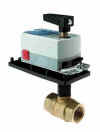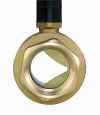
White Paper
AutomatedBuildings.com
|
[an error occurred while processing this directive] |

White Paper
Jeff Dahnke
Siemens Building Technologies Inc
HVAC Products Division
www.valves-actuators.com
Ball vs. Globe
No longer a cost issue
In the past, ball valves had been attractive to HVAC control contractors primarily because they appeared to be half the price of a comparable globe valve. However, this included the purchase price of the valve only, and not the costs of extra pipe reducers and added installation time. That said, with the advent of new ball valves and more competitively priced globe valves, the decision on whether to use a globe or ball valve is no longer dictated by price. This paper addresses some technical differences between ball and globe valves and makes recommendations on factors to consider when selecting the proper valve.
|
|
|
|
|
|
|
|
|
|
|
|
|
|
|
[an error occurred while processing this directive] |
Technical Comparison
Technically, the globe valve has a stem and plug, which strokes linearly, commonly referred to as "stroke" valves. The ball valve has a stem and ball, which turns horizontally, commonly referred to as "rotational" valves. Early ball valves used a full port opening, allowing large amounts of water to pass through the valve. (See figure below.) This gave HVAC controls contractors the ability to select a ball valve two to three pipe sizes smaller than the piping line size. Compared to traditional globe valves that would be only one pipe size smaller than the line size, this was often a more cost-effective device-level solution. In addition, the ball valve could be actuated by a damper actuator, rather than expensive box-style "Mod" motors.

Ball Valve
Close-up of "Flow Optimized" or Characterized Ball Valve
Pricing Comparison
[an error occurred while processing this directive]Today, with equivalent pricing between ball and globe valves, the full port ball valve is falling out of favor for most HVAC control applications. This is also due to its poor installed flow characteristic that leads to its inability to maintain proper control. New "flow optimized" ball valves, specifically designed for modulating applications, have been developed. Flow optimized ball valves are sized the same way as globe valves. They provide an equal percentage flow characteristic, enabling stable control of fluids. Additionally, there are more cost-effective valve actuators now available for globe valves. Better control and more-competitive pricing now puts globe valves on the same playing field as "Flow Optimized" ball valves.
Most Cost-effective by Application
Let's look at a cost comparison as it relates to the decision to select ball or globe valves. For terminal unit applications requiring less than 25 GPM, the globe valve is a more cost-effective choice. However, on larger coils the "Flow Optimized" ball valve is the more cost-effective solution. From a practical stand point, many jobs will use mostly one type or the other. If the majority of valves on a project tend to be terminal unit valves, then globe valves would offer better control at a lower price. If the majority of the valves are for AHU's (1-1/4"or larger) Flow Optimized Ball Valves are the preferred solution from a pure cost standpoint. Different tolerances to temperature, pressure and steam should also be considered in the selection process.
Selection Guidelines
Flow Optimized Ball Valve
Globe Valve
* This equates to a pump head pressure of
approximately 230 ft. Not very common HVAC applications
** Valve can be line sized to minimize pressure losses; butterfly valves are
also used for these applications.
[an error occurred while processing this directive]
[Click Banner To Learn More]
[Home Page] [The Automator] [About] [Subscribe ] [Contact Us]